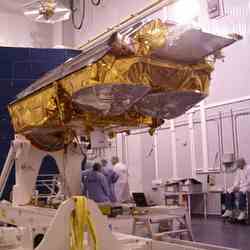
First CryoSat satellite during launch campaign. Image credit: ESA Click to enlarge
At the latest meeting of the European Space Agency’s Earth Observation Programme Board, which took place at ESA’s Headquarters in Paris on 23 and 24 February, ESA received the green light from its Member States to build and launch a CryoSat recovery mission, CryoSat-2.
The launch of the CryoSat spacecraft was unfortunately aborted on 8 October 2005 due to a malfunction of its Rockot launcher, which resulted in the total loss of the spacecraft.
“This decision is very important, as the scientific community in Europe and elsewhere is eagerly awaiting resumption of the CryoSat mission. We are happy to have obtained approval today”, said Volker Liebig, ESA Director of Earth observation programmes.
A CryoSat recovery plan was presented to the Programme Board by ESA’s Executive, which explained the status of ongoing activities and outlined the preparatory work leading to a CryoSat-2 mission, expected to be launched in March 2009.
CryoSat-2 will have the same mission objectives as the original CryoSat mission; it will monitor the thickness of land ice and sea ice and help explain the connection between the melting of the polar ice and the rise in sea levels and how this is contributing to climate change.
The positive decision on CryoSat-2 will allow rational use to be made of the technical and industrial competences for the original mission, as well as best use of the ground segment facilities and operational setup planned for that first mission. It means that the pre-launch scientific validation campaigns over land ice and sea ice can resume with the support of national institutes.
Original Source: ESA Portal
